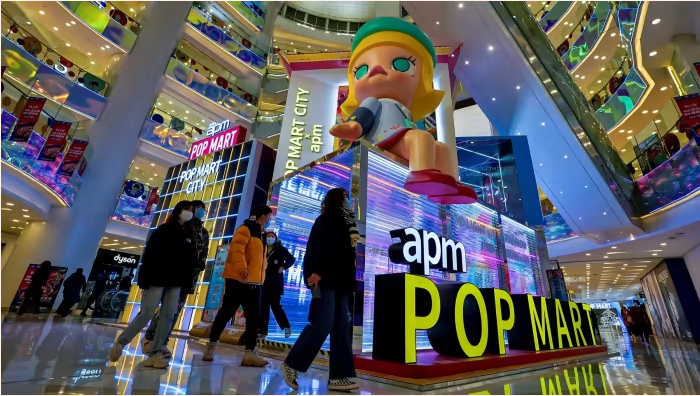
image via FT.com
Pop Mart has elevated toy-buying to an act of trendy connoisseurship among China’s young affluent consumers. Now it wants to emulate fellow domestic brands such as social media platform TikTok and online fashion retailer Shein by capturing the attention of western consumers.
Such is the popularity of the group’s colorful cutesy characters in its home market, the buying craze for them prompted one state-affiliated group to warn that Pop Mart was fueling overconsumption and waste.
The reprimand came after an avid collector in January bought 106 KFC meals at once just to get his hands on a Pop Mart toy as part of a promotion. Others paid proxies to order food for them or simply discarded their meals after buying them.
Pop Mart spawned a frenzied market for its toys by successfully navigating China’s powerful but fickle youth culture trends, even launching a social media and toy-trading app where toy hunters can show off their latest hauls and swap tips on the newest trends. Now the group is turning its attention to international expansion.
“In the long term, we will exceed 50 per cent [overseas revenue],” Justin Moon, Pop Mart’s vice-president in charge of international business, said, adding that he hoped to do so within four or five years. He cited Lego, the world’s biggest toymaker, which is betting big on expansion in Asia but still derives more than 80 per cent of its income from the US and Europe, the Middle East and Africa. “So we think this space is very big.”
Pop Mart opened its first European store in London in January and has plans to reach a total of between 40 and 50 overseas outlets this year. Including the London store, it already has 18 outlets outside China.
The company works with designers and artists to develop its characters, ranging from wide-eyed alligators to canine astronauts. It released a collection last year themed around the work of US artist Keith Haring and recently launched a collaboration with designer skiwear label Moncler.
Launched in 2010, Pop Mart has been credited with creating the market for so-called designer toys and last year made gross profits of Rmb2.8bn ($424mn). The company has 288 outlets and more than 1,800 vending machines known as “roboshops” in China and earned Rmb4.5bn in revenue last year. About half of its revenue comes from its shops and vending machines, with most of the rest coming from online sales.
Some of the most desirable smaller Pop Mart toys often sell to avid collectors for Rmb1,000 or more on the second-hand market, a space that has seen investment from prominent venture capital groups including Sequoia.
The company is known for its trademark “blind boxes”, which contain an unidentified character and sell for Rmb59-Rmb69 each. The format drives sales by prompting repeated purchases from customers seeking to secure the rarest collectibles.
The trend catapulted Pop Mart to a $676mn listing in Hong Kong in December 2020, giving it a market capitalization of $7bn.
But the group’s revenue growth slowed in the six months to December 31, with sales 60.3 per cent higher year on year compared with 116.8 per cent growth in the previous six months. Its shares are now trading below their offer price.
Pop Mart’s typical customers are China’s increasingly affluent teenagers and young adults. This has given the group room to grow domestically, despite the country’s dwindling birth rate reducing the relative size of its child population, according to Camille Gaujacq, an analyst at Daxue Consulting.
iiMedia Research, a data analysis company, estimates that the Chinese designer toy market was worth Rmb38.4bn in 2021 and will grow almost 50 per cent to Rmb57.5bn by 2023.
But analysts say that China’s latest Covid-19 outbreak has weakened consumer sentiment and threatens to dent Pop Mart’s growth.
Gaujacq said that while there was a market for Pop Mart’s toys outside China, it was hard to tell how far a growth model based on spurring a consumer trend could fuel the company’s expansion in the west.
International growth was Pop Mart’s “most important development focus”, said Moon, the vice-president, adding that while he acknowledged the “massive challenge” of convincing foreign consumers to buy into a Chinese trend, strong sales at the UK store gave him reason to be confident.
Moon said that while consumer “tastes are completely different” in the west, “you can’t find anything like our products in these places. To local people these things are really fresh.” He added that while initial uptake of Pop Mart characters was quicker in east and south-east Asian countries, where the group is also opening outlets, ultimately “our products don’t have national borders”.
“When people see this product they don’t ask, where are you from, are you Chinese, or American or British?” said Moon, grasping a foot-high astronaut figurine with a head the size of a cantaloupe. “The reason our products are well received in places around the world is that they don’t have any nationality . . . they come from another world.”
Source: Financial Times May 3, 2022 | By William Langley